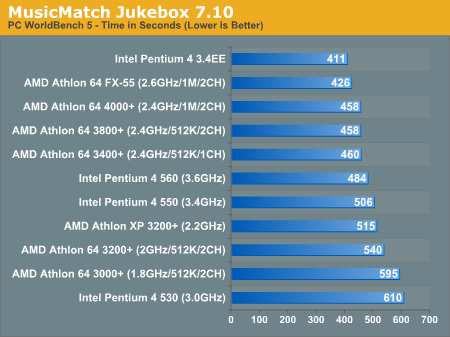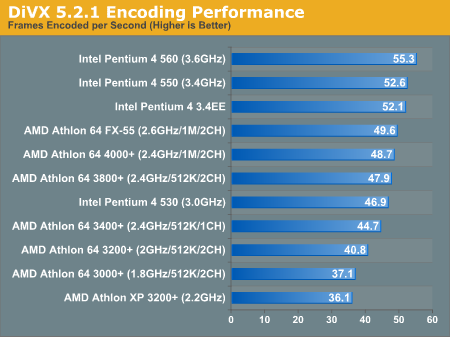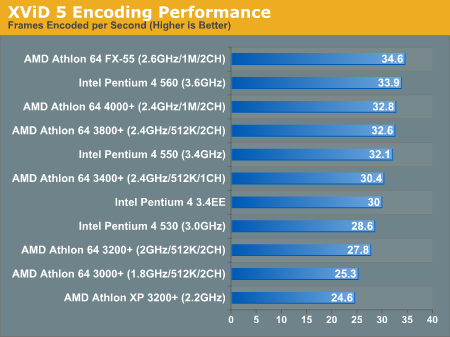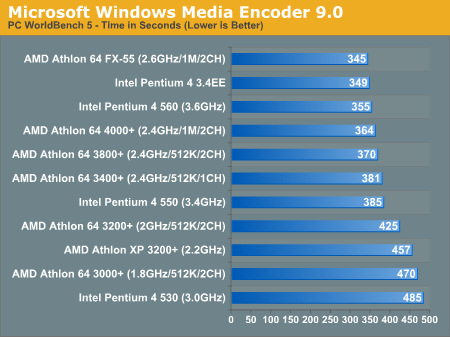AMD Athlon 64 4000+ & FX-55: A Thorough Investigation
by Anand Lal Shimpi on October 19, 2004 1:04 AM EST- Posted in
- CPUs
Audio/Video Encoding
MusicMatch Jukebox 7.10
An audio encoding favorite of Intel's from past Pentium 4 launches, MusicMatch Jukebox shows the Pentium 4 3.4EE taking a small 3.5% lead over the FX-55. Despite Intel's first place victory here, AMD takes the next four spots. Once again we see that there's no performance difference between the 3800+ and the 4000+, but looking at the lack of performance improvement from the 3400+ to 3800+ jump we see why: MP3 encoding is quite CPU bound, larger caches and more memory bandwidth don't matter much, it's all about clock speed here. Thus it's not too surprising to see the Athlon XP 3200+ outperform the Athlon 64 3200+ thanks to a shorter pipeline and higher clock speed. AMD's on-die memory controller does little for it here, neither does Intel's Prescott core though.

DiVX 5.2.1 with AutoGK
Armed with the latest version of DiVX (5.2.1) and the AutoGK front end for Gordian Knot, we took all of the processors to task at encoding a chapter out of Pirates of the Caribbean. We set AutoGK to give us 75% quality of the original DVD rip and did not encode audio.
Despite AMD becoming more competitive in DiVX encoding performance, Intel once again pulls head, with the Pentium 4 560 pulling away as the fastest DiVX encoder out of the bunch. Even the more reasonably priced Pentium 4 550 is able to outperfom the Athlon 64 FX-55, and it's not until we drop down to the 3GHz mark that AMD is able to win any ground.
Heavy optimizations for NetBurst give Intel the DiVX encoding performance crown.

XViD with AutoGK
Another very popular codec is the XViD codec, and thus we measured encoding performance using it instead of DiVX for this next test. The rest of the variables remained the same as the DiVX test.
Using XViD the performance situation is flipped on us, this time instead of Intel being on top we're left with the Athlon 64 FX-55 - although it's worth mentioning that the Pentium 4 560 is close behind. To no surprise there's a noticeable increase in performance from the single channel 3400+ to the dual channel Socket-939 3800+ of 7% to be exact. Once again we see no performance boost for the additional cache of the Athlon 64 4000+.

Windows Media Encoder 9
To finish up our look at Video Encoding performance we've got two tests both involving Windows Media Encoder 9. The first test is WorldBench 5's WMV9 encoding test.
Here we see that the Athlon 64 FX-55 and Pentium 4 3.4EE are basically tied for the first place position, followed by the Pentium 4 560 and all of the 2.4GHz Athlon 64s. Here the Athlon 64 3400+ appears to do about as well as the Pentium 4 550, which is either saying a lot for the Pentium 4 550 or very little for the 3400+.

But once we crank up the requirements a bit and start doing some HD quality
encoding under WMV9 the situation changes dramatically.
Here the Pentium 4 560 takes the lead, followed by the Pentium 4 3.4EE
and then the FX-55. The performance difference between the Pentium 4 560
and
the FX-55 is just under 9%, enough to give Intel the clear win here. Only
the Pentium
4 530 is really able to be challenged by the AMD chips.

Closing up our video encoding tests, while AMD does win some, with appropriate optimizations in place Intel seems to be the right candidate here.










89 Comments
View All Comments
RaistlinZ - Tuesday, October 19, 2004 - link
I may have missed it, but does anyone know if the Athlon 64 4000+ will be multiplier unlocked like the FX-53 is? That's the only thing I see that would differentiate the two chips.RaistlinZ - Tuesday, October 19, 2004 - link
Illissius - Tuesday, October 19, 2004 - link
Re: the necessity of Prescott. You are missing one very important consideration: Prescott has iAMD64 support. (Although it is currently disabled, no doubt because Intel has intentions of selling you the same processor twice). A simple die shrink of Northwood would not.I half suspect one of the reasons for Prescott's problems could be that AMD's 64-bit extensions don't mesh very well with a Netburst architecure, but they had to shoehorn it in anyways, and had to make a lot of unappealing design decisions in the process. (I've never designed a processor, though, so this is just baseless speculation.) I'd be interested in seeing 64-bit enabled chips on a Pentium M architecture...
CrystalBay - Tuesday, October 19, 2004 - link
Moores law is dead...:(Runamile - Tuesday, October 19, 2004 - link
Awsome read. Great Job. And HOLY COW does Intel get their a$$ handed to them!I would of liked to see some price/performance curves too. That would of summed it up quite nicely.
hertz9753 - Tuesday, October 19, 2004 - link
Athlon 64 3700+ 2.4GHz 1MB 64-bitAthlon 64 3400+ 2.4GHz 512KB 64-bit
Athlon 64 3400+ 2.2GHz 1MB 64-bit
araczynski - Tuesday, October 19, 2004 - link
nice, but luckily i still see no reason to upgrade my 2.4@3.3, at least not for a few measly benchmark FPS.hertz9753 - Tuesday, October 19, 2004 - link
AlphaFox - Tuesday, October 19, 2004 - link
Id like to see some kind of comparison with an OC XP Mobile. I have one runing at 2.46ghz and not really sure how it stacks up here...PrinceGaz - Tuesday, October 19, 2004 - link
An excellent article, well done.About the only thing missing was a bit of overclocking of the FX-55 to see if the introduction of strained silicon considerably increased the headroom. Obviously it has allowed them to ship parts rated at 2.6GHz which they weren't previously able to do, but how much better is the FX-55 compared to a CG-stepping FX-53? Does the use of strained silicon mean the FX-55 is a new stepping?